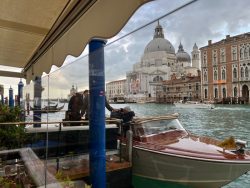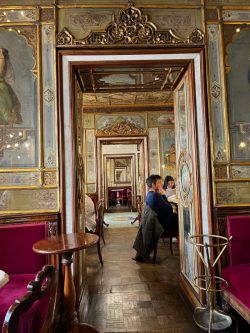 VENICE is one of the most beautiful cities in the world. Perhaps the most beautiful. And it has some famous (and famously expensive) hotels and restaurants. But with the emphasis on seafood, of course, and the traditional dishes such as fegato, it doesn’t have any kind of vegetarian food culture.
VENICE is one of the most beautiful cities in the world. Perhaps the most beautiful. And it has some famous (and famously expensive) hotels and restaurants. But with the emphasis on seafood, of course, and the traditional dishes such as fegato, it doesn’t have any kind of vegetarian food culture.
So when we went to the city for a short break with a vegetarian friend, she was totally braced for a narrow choice of “red sauce” with spaghetti (or other pasta), although there would be gorgeous puddings (Venice was where we first had tiramisu, many years ago) and pastries.
Looking at menus displayed outside restaurants and cafes, our expectations were confirmed. But our experience, over many years, in many countries, has taught us that if you ask, you may get – and you may get something very special.
 Certainly that was the case for our friend, right from the start. We stayed at Locanda La Corte, a little guest-house in a former convent, a 500-year old building in Castello near Campo Santa Maria Formosa. On previous visits it had just had breakfast in the courtyard, but now there is an elegant restaurant, and the food is imaginative, stylish and delicious.
Certainly that was the case for our friend, right from the start. We stayed at Locanda La Corte, a little guest-house in a former convent, a 500-year old building in Castello near Campo Santa Maria Formosa. On previous visits it had just had breakfast in the courtyard, but now there is an elegant restaurant, and the food is imaginative, stylish and delicious.
The menu was not veggie-friendly – pasta with red sauce seemed the only option. But as soon as we explained, the young waiter headed for the kitchen and returned to say that the chef would make pasta e fagioli (pasta and beans) for her. This turned out to be a historic speciality, now found across the country but originating in the Veneto.
 The following night, deciding to stay in because of heavy rain, the chef produced another Venetian speciality for her: ravioli with dark radicchio and potato and a cream sauce. It was unusual and delicious.
The following night, deciding to stay in because of heavy rain, the chef produced another Venetian speciality for her: ravioli with dark radicchio and potato and a cream sauce. It was unusual and delicious.
It was the same everywhere we went – nothing much on the menu, but as soon as we explained, suggestions came pouring out – imaginative risottos, many pasta possibilities and other ideas. It was rather as if the chefs wanted the chance to show off local produce and their own skills, but not to advertise them in a city which depends on fruit and vegetables that have to be imported (at some cost) from the mainland or further afield.
 At the Gritti Palace, we began, extravagantly with cocktails on the terrace looking across the Grand Canal to Santa Maria della Salute (actually the drinks were a lot less expensive than we had expected). You sit there, under the awning, with your drinks (we had the Gritti’s Basilicata, White Lady and the Last Cocktail) and olives, watching elegant launches bring and collect guests – the canal side is the main entrance – dreaming of the great and the famous and the super-rich for whom this place for so many years has provided a home when they come for the Biennale, Carnavale or film festival.
At the Gritti Palace, we began, extravagantly with cocktails on the terrace looking across the Grand Canal to Santa Maria della Salute (actually the drinks were a lot less expensive than we had expected). You sit there, under the awning, with your drinks (we had the Gritti’s Basilicata, White Lady and the Last Cocktail) and olives, watching elegant launches bring and collect guests – the canal side is the main entrance – dreaming of the great and the famous and the super-rich for whom this place for so many years has provided a home when they come for the Biennale, Carnavale or film festival.
Rain again drove us under cover, into the Bar Longhi (nominated as an international top bar in the Financial Times’ How To Spend It supplement – just saying) with its dazzling stained glass and mirrors. Here we had a late lunch from the light plates menu – tempting selections which included a dark goat’s cheese and rigatoni dish, felicetti with seafood and another but also delicious pasta e fagioli.
 The reason for the visit (do you really need a reason to go to Venice?) was our friend’s 50th birthday – but the visit also coincided with the continuing celebrations of the 1600th anniversary of the founding of Venice.
The reason for the visit (do you really need a reason to go to Venice?) was our friend’s 50th birthday – but the visit also coincided with the continuing celebrations of the 1600th anniversary of the founding of Venice.
Like so many big events of 2020, the anniversary plans had all come to nothing. They included a huge city-wide exhibition, but this was partially saved, scaled back and installed in the Doge’s Palace for 2021, so we were able to get a taste of what the whole exhibition might have been, and to learn so much about the city, its development, its people, the trade, the art, the architecture, daily life, war, opera, plague …
In a weekend visit – arriving Friday afternoon, leaving Monday morning – you basically have two days. You can run yourself ragged and try to see everything. Only, of course, you cannot even begin to see a tiny fraction of Venice in two days – it’s a lifetime’s work. So you cherry pick and you walk and you look and you get happily lost.
We went to the Basilica San Marco, we walked to the Rialto and through the markets, we took a gondola (hell, it was a special birthday and it was a beautiful day and none of us had ever been in a gondola and it was lovely), we went to the Doge’s Palace, we took a vaporetto along the Grand Canal and we had coffee at Florians on the Piazza San Marco.
And we discovered another important 2020 birthday – the 300th anniversary of Florians, which has always been one of our favourite places in Venice. Missing out on visitors in 2020, they had decided to celebrate the anniversary throughout 2021 so we raised our coffee and tea cups to one of Europe’s oldest coffee houses and certainly the most gloriously situated.
 Apart from the Saturday evening rain and the sudden storm on Sunday, the weather was bright and cold, perfect for late autumn. As we travelled back across the lagoon to Marco Polo airport, we could see the snow on the mountains. We arrived back in England to the aftermath of Storm Arwen. You do feel a bit smug (but a wee bit guilty) when you have been sipping cocktails while everyone at home has been sheltering from gales and falling tiles and battling with floods.
Apart from the Saturday evening rain and the sudden storm on Sunday, the weather was bright and cold, perfect for late autumn. As we travelled back across the lagoon to Marco Polo airport, we could see the snow on the mountains. We arrived back in England to the aftermath of Storm Arwen. You do feel a bit smug (but a wee bit guilty) when you have been sipping cocktails while everyone at home has been sheltering from gales and falling tiles and battling with floods.
Back at home, we wanted to know more about pasta e fagioli, and found the answers, as usual, in a book by our favourite Italian food writer, Anna del Conte, who taught me how to make risotto and has inspired us and countless others for so many years with her knowledge, clear recipes and no-nonsense style.
Pasta e fagioli alla Veneto
The best beans – borlotti – grow in the Veneto, so perhaps it is not surprising that this humble but delicious legume is the star of a dish that has its roots back in Roman times, even before the founding of the city of Venice.
You should, of course, do it properly and soak the beans overnight, but the truth is most of us don’t have the time or patience, and tinned borlotti beans are very good. The original recipe calls for ham or bacon (Anna says unsmoked pancetta as well as unsmoked ham or bacon) but it works fine without.
It is a classic, simple peasant soup – olive oil, chopped garlic, onion, carrot and celery, fresh rosemary, stock, small pasta (such as ditalini or conchigliette). salt, freshly ground black pepper and freshly grated Parmesan.
 The history is fascinating – in the Veneto, the dish is linked with the ritual of the killing of the pigs on 17th January, the feast of Sant’Antonio Abate. The prime cuts would go to the wealthy in the community, with the poorer peasants getting the remaining parts to be eaten immediately or smoked. Potatoes and some of the cheaper smoked meat would be cooked with the pasta and beans.
The history is fascinating – in the Veneto, the dish is linked with the ritual of the killing of the pigs on 17th January, the feast of Sant’Antonio Abate. The prime cuts would go to the wealthy in the community, with the poorer peasants getting the remaining parts to be eaten immediately or smoked. Potatoes and some of the cheaper smoked meat would be cooked with the pasta and beans.
Pictured: A glorious day for a gondola trip; the view from the terrace of the Gritti Palace Hotel; Bar Longhi in the Gritti Palace; Florians; ravioli with red radicchio and potato and cream sauce.